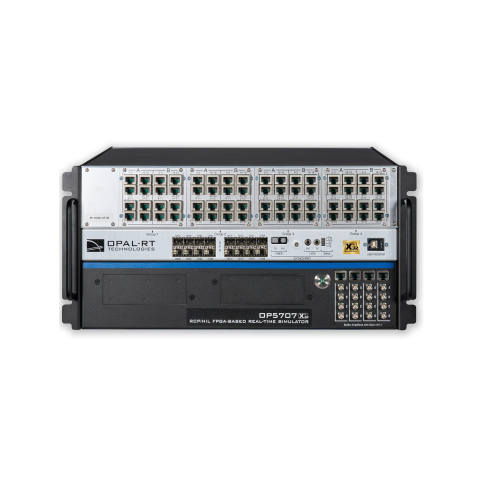Motor Emulation
We partner with D&V to integrate leading-edge technology and innovative design, delivering superior power hardware-in-the-loop (PHIL) simulation for EV/HEV motor drive inverters and DC power system test solutions.
PHIL for motor emulation and DC power systems testing is unquestionably changing the product development landscape in comparison to traditional analog test benches (Dyno Testing). PHIL simulation permits users to run a significant quantity of test cases incorporating multiple failure configurations previously inconceivable with traditional methods. It also enables full power testing without users in the vehicle and without real vehicle components.
Extend your EV/HEV control design and test strategy by including the same simulation tools from HIL validation in R&D to manufacturing and testing with the same software platform–and in the process decreasing product development costs, improving the product, and reducing time to market.

Advantages
Validate your powertrain system with OPAL-RT
Streamline your validation process with our electric powertrain simulation solutions. Designed to meet the rigorous demands of modern testing, our systems ensure unparalleled accuracy, flexibility, and integration for a wide range of automotive and industrial applications.
01
High fidelity
02
Flexibility
03
Full integration
04
Trusted by industry leaders, driven by innovation
Webinar
Testing the future
Our partnership with D&V enables unmatched test agility across the full EV development cycle. With the combination of our high-fidelity real-time simulation platforms and D&V’s state-of-the-art Power Emulator, we can convert a wider range of simulations than ever before from HIL to PHIL.
FAQ
Find the answers to your questions
What communication protocols do you support?
Consult our comprehensive list of supported protocols here: Communication Protocols.
How does OPAL-RT’s e-motor emulator work, and what benefits does it offer?
Our e-motor emulator solution (also referred to as an electric motor emulator) mimics the dynamic behavior of an electric motor in real time. It replicates key performance characteristics such as torque, speed, and efficiency, and generates realistic load conditions that accurately represent operational scenarios. This emulator allows automotive engineers to validate motor control algorithms and ensure compatibility with the entire powertrain. By leveraging a high-fidelity emulator, you can fine-tune your designs under simulated, yet realistic, driving conditions before progressing to physical prototyping saving both time and resources.
In what ways does your solution address DC power systems, and how does the DC emulator factor in?
In electric vehicles, DC power systems play a crucial role in energy distribution, battery management, and the integration of various power electronic devices. Our platform includes a DC emulator that precisely models the behavior of DC power systems enabling simulation of battery dynamics, DC-DC converters, and load interactions. This comprehensive emulation helps engineers study voltage and current fluctuations, manage energy flow effectively, and test protective strategies under transient conditions. The ability to simulate DC power systems in real time improves validation of system performance and supports the safe integration of components within the overall powertrain architecture.
What are the key benefits of using OPAL-RT’s electric powertrain simulation for automotive development?
Using our electric powertrain simulation brings several advantages:
- High-Fidelity Modeling: Replicates complex interactions within electric powertrains, including the performance of e‑motor emulators and DC power systems.
- Speedy Iterations: Enables rapid prototyping and testing of control strategies before hardware is built, reducing time-to-market.
- Risk Mitigation: Facilitates thorough testing under simulated conditions that closely match real-world operating scenarios, lowering the risk of costly redesigns.
- Integrated Testing Environment: Combines simulation with Hardware-in-the-Loop (HIL) testing, ensuring that both software and hardware components perform reliably together. This integrated approach helps automotive manufacturers optimize system design and enhance overall vehicle performance.
How can OPAL-RT’s automotive motor emulation be integrated into my overall vehicle testing strategy?
Our automotive motor emulation solution is designed to seamlessly integrate with your existing vehicle testing setups. The solution supports connectivity with a wide range of measurement systems and control platforms, allowing engineers to combine real-time simulation with physical prototypes or components. Whether you’re using the e‑motor emulator to evaluate motor dynamics or the DC emulator to study power distribution, the platform provides a comprehensive framework for model-based design and Hardware-in-the-Loop (HIL) testing. This integration enables you to perform component-level tests as well as complete system-level evaluations, fostering a streamlined path from concept to fully validated production hardware.




